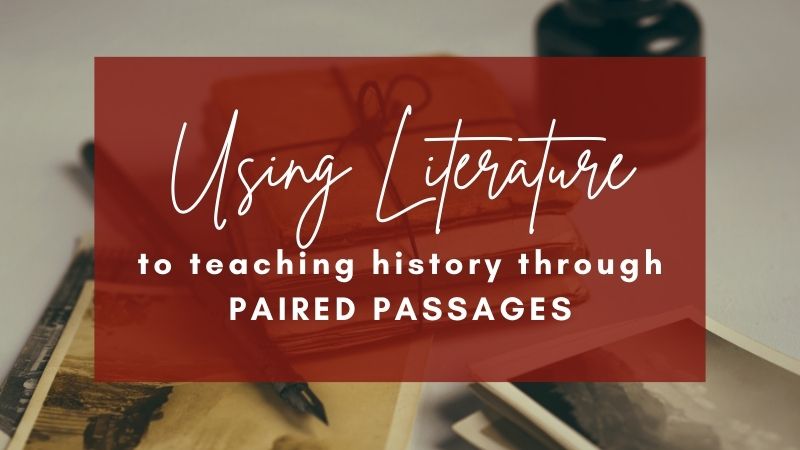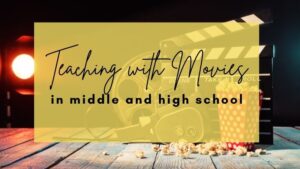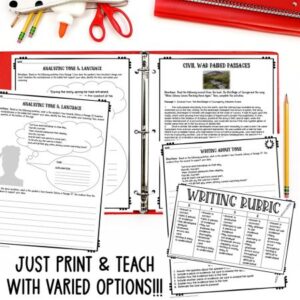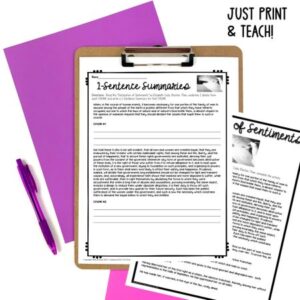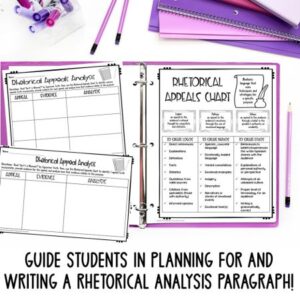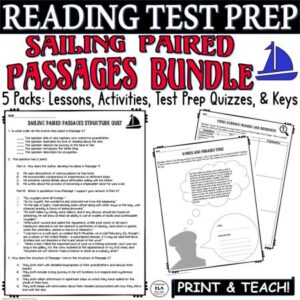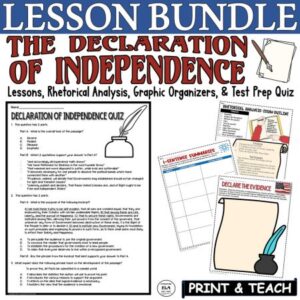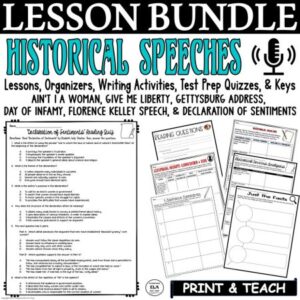My journey using literature to teach history through paired passages did NOT begin in college. Obviously, no one goes into teaching thinking the following: “I cannot wait to prepare my students for analyzing paired passages on a standardized test!” I think we all have slightly more lofty goals, or at least I hope so!
Most people go into teaching because of a particular teacher who had an impact on their lives or because they thought school was fun or a way out of a difficult situation. Many also desire to make a long-lasting impression on students in some way. Maybe we can help them think more critically, read more thoughtfully, or write more coherently. For me, it was a mixture of many reasons.
I am passionate about literature; however, I also love history. On family vacations, we visited historical places like Jamestown, Fredericksburg, Stone Mountain, etc. If it connected to history in some way and was located within fifteen hours of South Florida, my parents traveled to it! And I still desire to transmit these experiences to my students by using literature to teach history, so they can make their own connections to the past!
Keep reading to learn more about using literature to teach history through paired texts!
Need help with Test Prep? Check out this FREE Pack of 3 Test Prep Activities to help students achieve success on standardized tests!
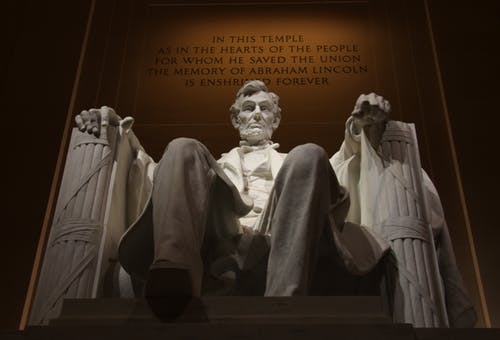
Why I Went Into Teaching and Started Using Literature to Teach History
In high school, I had 2 fantastic teachers: Mr. Canning, my English Teacher, and Mrs. Allen (formerly Ms. Smith), my math teacher. Both teachers taught me for more than one year, and I enjoyed their teaching styles immensely. Ms. Smith was a one-of-a-kind math teacher, which for a reader and lover of language, was quite rare.
I still actually enjoy math, because I am quite good at it. She taught every problem step by step, and her methodical style appealed to me. I am most certainly an “I Do, We Do, You Do” proponent as was she. I got to have Ms. Smith for 4 full years from Geometry through Calculus, and I will never forget her.
Ultimately though, one of my favorite moments of high school was in 11th grade English. When Mr. Canning challenged us to present a novel in a creative way, I became a Civil War nurse from The Red Badge of Courage who sang “When Johnny Comes Marching Home.” My mom helped me to put together a Civil War-looking nurse outfit complete with a button-down white shirt and dark navy blue skirt. I even tied my hair into a bun; oh yeah, I looked the part 🙂
Hey, I tried!
In my ten-minute presentation, I spoke of the horrific conditions that the soldiers experienced in the North and the South, described the various medical tools used, and sang the entire song “When Johnny Comes Marching Home” as my finale.
This project helped to integrate history into literature, and it became a memory I still treasure today. With this one project, I had to read a piece of classical literature ( The Red Badge of Courage ), research the historical period, prepare by drafting what I would say or sing ( “When Johnny Comes Marching Home” ), and present this information in an original format in front of a bunch of high school students, along with my teacher, Mr. Canning, of course.
This memory instilled a belief that as an English Teacher, I should be using literature to teach history through connected passages, so my own students could benefit as well!
When we integrate subject areas through concepts, skills, and/or texts, students learn more and learn it more fully!
Click to read about TEACHING WITH MOVIES IN MIDDLE AND HIGH SCHOOL!
How can I start using literature to teach history through paired passages for my own classroom?
In the current educational climate, many of us may be thinking, “How can I expose my students to history and literature as well as prepare them for paired passages they will encounter on standardized tests?” Well, we can do both! Choosing texts is SO important when using literature to teach history.
One of the first paired passages I put together was inspired by The Red Badge of Courage and “When Johnny Comes Marching Home.” I broke down 5 of the standards including Citing Evidence, Central Idea/Theme, Characterization, Words and Phrases, and Structure. You can do the same thing too as you explore using literature to teach history!
Use Paired Passages with Questions to prepare for Standardized Tests and teach History in Literature
Here is a list of possible combinations for using literature to teach history in paired passages:
1. The Red Badge of Courage and “The Charge of the Light Brigade”
These 2 texts tell the story of bravery in the midst of war and courage in the heat of battle. If you are teaching American Literature or United States History, including an excerpt from The Red Badge of Courage by Stephen Crane may give your students insight into the American Civil War (1861-1865).
“The Charge of the Light Brigade” by Alfred Lord Tennyson tells the true story of an immense act of daring and fearlessness in the Battle of Balaclava around 7 years before the American Civil War. Comparing and contrasting the perspectives in both texts might help in using literature to teach history and remember it.
Students come face to face with the realities and consequences of war by teachers using literature to teach history!
Click on the image below to get two Civil War passages to help you teach literature and history!
2. “Child Labor” and “Declaration of Sentiments”
Women’s rights came to ultimate fruition in the 20th century, but so many women laid the groundwork for those rights many years before in the 19th century. If you are about to cover this topic, ensure you are using literature to teach history!
Elizabeth Cady Stanton’s “Declaration of Sentiments” mirrors Jefferson’s Declaration of Independence to highlight the incredible inequality of opportunities between men and women. It might be difficult for middle and high school students to completely understand the past injustices women faced, so reading this historical speech will be of great value.
Additionally, a speech about child labor by Florence Kelley argues for the rights of women, particularly the right to vote; this speech lays the foundation for what many women hoped to accomplish through suffrage. If you choose to read both texts, make sure to allow for a week or two of analysis and add in film clips and/or historical documentaries to help with your students’ comprehension!
3. “Gettysburg Address” and “Ain’t I a Woman?”
If you have not read Abraham Lincoln’s “Gettysburg Address,” definitely consider including it in your curriculum. It is short, rigorous, and relevant; teaching this speech will take you less than two class periods to read, annotate, and complete an activity or two!
Plus, in the context of teaching about the American Civil War, this speech will add to the meaning and purpose of Sojourner Truth’s “Ain’t I a Woman?” which students will be able to comprehend more easily!
This primary source is, or should be, a mainstay in education because of its factual descriptions of historical realities that cannot be denied. The experiences of Sojourner Truth and others who suffered beyond what most can comprehend MUST be read, so history does not repeat itself.
After living in slavery, Truth escaped to freedom with her baby. Over time, she worked to do more than just survive; she fought for others to have the same freedoms and rights as those in power at the time.
In using literature to teach history within these two passages, students will exponentially increase their awareness of important societal issues many around the world faced yesterday and today.
Get the full Ain’t I a Woman? BUNDLE!
4. “Paul Revere’s Ride” and “The Speech at the Virginia Convention”
I am a huge fan of the period surrounding the American Revolution. The poem “Paul Revere’s Ride” by Henry Wadsworth Longfellow and the speech “The Speech at the Virginia Convention” by Patrick Henry are captivating and meaningful in the light of the United States’ early history.
Using literature to teach history can make real-life stories come alive to all who read them!
5. “To My Dear and Loving Husband” and “The Gift of the Magi”
These paired texts offer unique insights into differing times in human history. They both reveal certain sacrifices and immense love within marriage, even though these two texts are separated by almost three hundred years. Delving more deeply into this poem and short story may help students understand more about the relationships between men and women throughout history.
6. Joshua Slocum’s Sailing Alone Around the World (autobiography) and Howard Phillips Lovecraft’s The White Ship (short story)
Nowadays, the average person has not sailed away on the high seas to participate in a grand adventure; however, by reading Joshua Slocum’s Sailing Alone Around the World (autobiography) and Howard Phillips Lovecraft’s The White Ship (short story), one can get a small taste of another world in another time.
The rich description in the story and the interesting historical elements in the autobiography supply the reader with important contexts of another era. Being knowledgeable about this time in history is vital when using literature to teach history!
Click below for 5 days of lessons, activities, and mini-quizzes for these 2 paired passages!
7. Mark Twain’s Life on the Mississippi River and Mark Twain’s Adventures of Huckleberry Finn
Life in 1800s America is depicted humorously and energetically by the consummate American writer Mark Twain, also known as Samuel Clemens. He evokes the everyman with hearty, vigorous language without the ostentatious pomp of the previous generation of writers.
These two particular paired passages focus on the Mississippi River and can aid in using literature to teach history through the lens of politics, transportation, law, slavery, the land, etc.
8. Mark Twain’s Adventures of Tom Sawyer and William Henry Davies’ poem “Leisure”
Growing up, my mom read Mark Twain’s Adventures of Tom Sawyer to my sister and me along with other great pieces of literature like Little Women and Treasure Island. I can still remember the story of Tom Sawyer getting other little boys to do his work for him and PAYING him for the honor.
The poem “Leisure” by William Henry Davies perfectly captures the essence of Twain’s Adventures of Tom Sawyer. And instead of reading the whole novel, one could easily read various passages from the book as vignettes. They are intriguing to most readers and may help students see a different world long ago.
9. The Declaration of Independence and “One Song America” by Walt Whitman
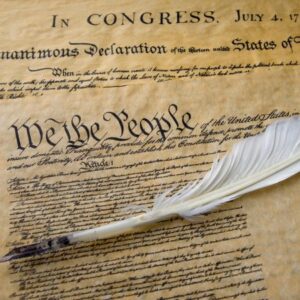
Years ago, I listened to an entire reading of the Declaration of Independence in my car on July 4th. Throughout my high school and college experiences, I had not read this pivotal piece of historical writing. In fact, I realize with embarrassment for our nation that while most students may have heard of various American writers and historical documents, they have most likely never actually read them or even heard them read.
How can we think to support our government and its decisions without knowing the truth of our past? Firsthand reading of documents like the Declaration of Independence should be required in all middle and high schools. It doesn’t take very long in the whole scheme of things, and ultimately, these literary experiences will reap great rewards.
Using literature to teach history is incredibly helpful as it reinforces what students learn in several of their classes!
10. The Declaration of Independence and “The Speech at the Virginia Convention”
Using literature to teach history with the Declaration of Independence and “The Speech at the Virginia Convention” can be done within a week early on in the year as students study the American Revolution. Both contain rhetorical appeals and devices for a singular, similar purpose: to argue for freedom from an oppressive government.
By showing students clips from various historical movies and listening to audio readings online, they can greatly add to their knowledge of how our country came to be and why we still must fight to keep our God-given rights today!
Clearly, using literature to teach history should become the standard in everyone’s education!
Click the bundle below for six speeches that will help you when using literature to teach history!

